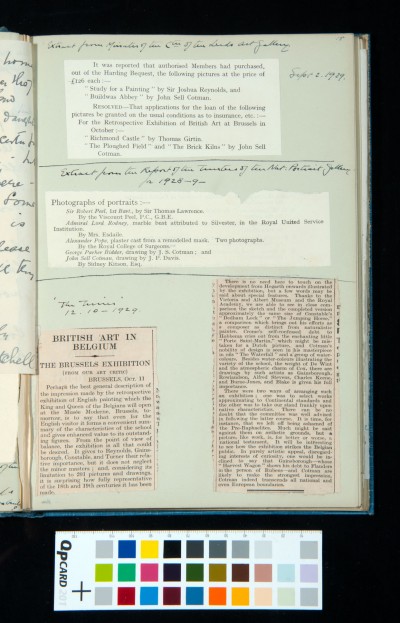Cotmania. Vol. IV. 1929-30
Archive: SDK Sydney Decimus Kitson Archive
Reference Number: SDK/1/2/1/4
Page: 10 recto (numbered 15)
-
Description
Extracts about the exhibition of English artworks in Belgium.
Art critic in Times says that Cotman 'transcends all national and even European boundaries.'
{Extract from Leeds Art Gallery Minutes}
{National Portrait Gallery Trustees Report Extract}
{Newspaper Clipping}{Extract from Leeds Art Gallery Minutes}
{National Portrait Gallery Trustees Report Extract}
{Newspaper Clipping}Date:
-
Transcription
{Extract from Leeds Art Gallery Minutes}
extract from minutes of the C[ommittee] of the Leeds Art Gallery.
Sept. 2.1929.
It was reported that authorised Members had purchased, out of the Harding bequest, the following pictures at the price of £126 each:-
“Study for a Painting” by Sir Joshua Reynolds, and
“Buildwas Abbey” by John Sell Cotman.
Resovled – That applications for the loan of the following pictures be granted on the usual conditions as to insurance etc. :-
For the Retrospective Exhibition of British Art at Brussels in October:-
“Richmond Castle” by Thomas Girtin.
“The Ploughed Field” and “The Brick Kilns” by John Sell Cotman.
----------------
{National Portrait Gallery Trustees Report Extract}
Extract from the Report of the Trustees of the Nat. Portrait Gallery for 1928-9
Photographs of Portraits:-
Sir Robert Peel, 1st Bart., by Sir Thomas Lawrence.
By the Viscount Peel, P.C., G.B.E.
Admiral Lord Rodney, marble bust attributed to Silvester, in the Royal United Service Institution.
By Mrs. Esdaile.
Alexander Pope, plaster cast from a remodelled mask. Two photographs.
By the Royal College of Surgeons.
George Parker Bidder, drawing by J. S. Cotman; and John Sell Cotman, drawing by J.P.Davis.
By Sidney Kitson, Esq.-------------------
{Newspaper Clipping}
'The Times'
12.10.1929British Art in Belgium
(From our Art Critic)
Brussels, Oct. 11
Perhaps the best general description of the impression made by the retrospective exhibition of English painting which the King and Queen of the Belgians will open at the Musee Moderne, Brussels, tomorrow, is to say that even for the English visitor it forms a convenient summary of the characteristics of the school and gives enhanced value to its outstanding figures. From the point of view of balance, the exhibition is all that could be desired. It gives to Reynolds, Gainsborough, Constable and Turner their relative importance, but it does not neglect the minor masters; and, considering its limitation to 201 pictures and drawings, it is surprising how fully representative of the 18th and 19th centuries it has been made.
There is no need here to touch on the developments from Hogarth onwards illustrated by the exhibition, but a few words may be said about special features. Thanks to the Victoria and Albert Museum and the Royal Academy, we are able to see in close comparison the sketch and completed version approximately the same size of Constable’s “Dedham Lock” or “The Jumping Horse,” a comparison which brings out his efforts as a composer as distinct from naturalistic painter. Crome’s self-confessed debt to Hobbema cries out from the enchanting little “Porte Saint-Martin,” which might be mistaken for a Dutch picture, and Cotman’s nobility of design is seen in his masterpiece in oils “The Waterfall” and a group of water-colours. Besides water-colours illustrating the variety of the school, the weight of De Wint and the atmospheric charm of Cox, there are drawings by such artists as Gainsborough, Rowlandson, Alfred Stevens, Charles Keene, and Burn-Jones, and Blake is given his full importance.
There were two ways of arranging such an exhibition; one was to select works approximating to Continental standards and the other was to take our stand frankly upon native characteristics. There can be no doubt that the committee was well advised in following the later course. It is time, for instance, that we left off being ashamed of the Pre-Raphaelites. Much might be said against them on aesthetic grounds, but a picture, like work, is, for better or worse, a national testament. It will be interesting to see how the exhibition strikes the Belgian public. In purely artistic appeal, disregarding interests of curiosity, one would be inclined to say tha Gainsborough – whose “Harvest Wagon” shows his debt to Flanders in the person of Rubens – and Cotman are likely to make the strongest impression. Cotman indeed transcends all national and even European boundaries.
